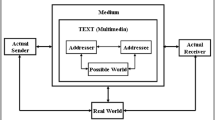Abstract
Dynamic phase-spaces are suggested as a way of designing and implementing interactive multimedia systems. A dynamic phase-space is a space of properties overlayed with dynamics. The space is “decorated” with multimedia resources such as pictures, music, sound-effects, speech, and movies.
This architecture may help resolve the basic problem of interactive systems, namely that both user and author need to influence the system. If the user is passive, the system is not interactive, but if the author has no power, no interesting narratives can be told. But how can two or more people influence the same system at the same time?
The solution presented in the paper is that the system objects are controlled by a global dynamics and neither party is allowed to influence the objects directly; they may only influence objects indirectly by perturbing the global dynamics. In this way, contradictory inputs from user and author have a well-defined solution.
The paper describes an experimental museum installation that implements these ideas. In addition, a set of interactive rhetorical patterns are defined and exemplified. The main theoretical inspiration of the system is Thom's catastrophe theory, although it is not used in a literal sense.
Similar content being viewed by others
References
E.J. Aarseth, Nonlinearity and Literary Theory, in Landow 1994, pp. 51–86, 1994.
E. Aarseth, “Cybertext,” Doctoral Dissertation, University of Bergen, 1995.
P. Bøgh Andersen, “Vector spaces as the basic component of interactive systems. Towards a computer semiotics,” Hypermedia, Vol. 4, No. 1, pp. 53–76, 1992.
P. Bøgh Andersen, “The force dynamics of interactive systems. Towards a computer semiotics,” Semiotica, Vol. 103, Nos. 1/2, pp. 5–45, 1995.
P. Bøgh Andersen and B. Holmqvist, “Interactive Fiction. Artificial intelligence as a mode of sign production,” AI and Society, Vol. 4, pp. 291–314, 1990.
P. Bøgh Andersen, J.W. Johannsen, J.A. Mikkelsen, and M. Sams, Interaktive Tekster (Interactive Texts), (to appear).
P.AA. Brandt, “Agonistique et analyse dynamique catastrophiste du modal et de l'aspectuel,” Semiotica, Vol. 77, pp. 1–3, 1989.
C. Bremond, “La logique des possible narratifs,” Communications, Vol. 8, pp. 60–76, 1966.
C. Bremond, “Morphology of the French folktale,” Semiotica, Vol. 2, pp. 247–276, 1970.
J. Carlsen, Odin and Harddisken (Wodan and the Harddisk), Centrum: Copenhagen, 1994.
G.P. Landow, Hyper/Text/Theory, The John Hopkins University Press: Baltimore & London, 1994.
B. Laurel, Computers as Theatre, Addison-Wesley: Redwood City, CA, 1991.
K.H. Madsen, “A Guide to Metaphorical Design,” The Communications of the ACM, Vol. 36, No. 12, pp. 57–62, 1994.
R. Ogawa, H. Harada, and A. Kameko, “Scenario-based hypermedia: A model and a system,” Hypertext: Concepts, Systems and Applications, N. Streitz, A. Rizk, and J. André (Eds.), Cambridge University Press: Cambridge, pp. 38–51, 1990.
R. Thom, Mathematical Models of Morphogenesis, Ellis Horwood: Chichester, 1983.
R. Thom, Semio Physics: A Sketch, Addison-Wesley Publ. Comp.: Redwood City, CA, 1990.
W. Wildgen, Catastrophe Theoretic Semantics, John Benjamins Publ. Comp.: Amsterdam, 1982.
W. Wildgen, Archentypen-Semantik, Gunter Narr Verlag: Tübingen, 1985.
Rights and permissions
About this article
Cite this article
Andersen, P.B. Multimedia Phase-Spaces. Multimedia Tools and Applications 6, 207–237 (1998). https://doi.org/10.1023/A:1009642713804
Issue Date:
DOI: https://doi.org/10.1023/A:1009642713804




